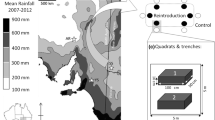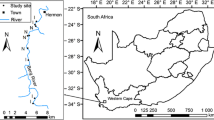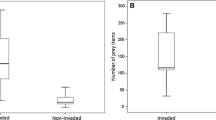Abstract
Invasive plants can have significant negative interactions with native flora and fauna, often decreasing the abundance and diversity of native plants and invertebrate and vertebrate herbivores. Less is known, however, about how invasive plants influence higher-order consumers, such as carnivores. Arundo donax is a globally distributed invasive grass that forms dense monotypic stands in the habitats where it successfully establishes. This study investigated the influence of Arundo invasion on mammal assemblages in California’s Santa Clara River Valley. Specifically, we aimed to determine whether Arundo alters habitat use for carnivores, and if so, assess the possible mechanisms driving these differences. We used remote cameras to evaluate carnivore habitat use and model occupancy, and live traps and remote cameras to assay abundance of small mammals, common prey of these larger predators. We found that detections of all carnivores were significantly lower in Arundo-dominated habitat patches, suggesting decreased preference for Arundo habitat. This was reflected in the occupancy model, which found the highest probability of coyote and bobcat habitat use in native patches and lowest in Arundo; however, habitat did not seem to be as important of a predictor as in the pooled species results. Small mammal abundance was similar if not higher in Arundo, suggesting the possibility of Arundo acting as a refuge for prey species and altered predator–prey dynamics in Arundo-dominated patches. This study improves our knowledge of the often-complex ways that invasive plants, like Arundo, influence the ecology and behavior of faunal communities in invaded ecosystems.




Similar content being viewed by others
References
Ahumada JA, Silva CEF, Gajapersad K et al (2011) Community structure and diversity of tropical forest mammals: data from a global camera trap network. Philos Trans R Soc B Biol Sci 366:2703–2711. https://doi.org/10.1098/rstb.2011.0115
Barton K (2019) Mu-MIn: multi-model inference. In: R package version 1.43.15
Bateman HL, Ostoja SM (2012) Invasive woody plants affect the composition of native lizard and small mammal communities in riparian woodlands. Anim Conserv 15:294–304. https://doi.org/10.1111/j.1469-1795.2011.00517.x
Bates D, Maechler M, Bolker B, Walker S (2015) Fitting linear mixed-effects models using lme4. J Stat Softw 67:1–48
Bell GP (1997) Ecology and Management of Arundo donax, and approaches to riparian habitat restoration in souther California. In: Brock JH, Wade M, Pysek P, Green D (eds) Plant invasions: studies from North America and Europe. Backhuys Publishers, Leiden, pp 103–113
Brooks ML, Antonio CMD, Richardson DM et al (2004) Effects of invasive alien plants on fire regimes. Bioscience 54:677–688
Burnham KP, Anderson DR (2002) Model selection and multimodel inference: a practical information-theoretic approach, 2nd edn. Springer, New York
Crooks KR, Burdett CL, Theobald DM et al (2017) Quantification of habitat fragmentation reveals extinction risk in terrestrial mammals. Proc Natl Acad Sci 114:7635–7640. https://doi.org/10.1073/pnas.1705769114
Delibes M, Blazquez MC, Rodriguez-Estrella R, Zapata SC (1997) Seasonal food habits of bobcats (Lynx rufus) in subtropical Baja California Sur, Mexico. Can J Zool 74:478–483
Dutra HP, Barnett K, Reinhardt JR et al (2011) Invasive plant species alters consumer behavior by providing refuge from predation. Oecologia 166:649–657. https://doi.org/10.1007/s00442-010-1895-7
Fedriani JM, Fuller TK, Sauvajot RM (2001) Does availability of anthropogenic food enhance densities of omnivorous mammals? an example with coyotes in Southern California. Ecography (Cop) 24:325–331. https://doi.org/10.2307/3683710
Fiske I, Chandler R (2011) Unmarked: an R package for fitting hierarchical models of wildlife occurrence and abundance. J Stat Softw 43:1–23. https://doi.org/10.18637/jss.v043.i10
Fiske I, Chandler R (2019) Overview of unmarked: an R package for the analysis of data from unmarked animals. In: R Package, pp 1–5. https://doi.org/10.1002/wics.10
Giessow J, Casanova J, Leclerc R et al (2011) Arundo donax (giant reed): distribution and Impact Report. California Invasive Plant Council, Berkeley
Gilbert SL, Sivy KJ, Pozzanghera CB et al (2017) Socioeconomic benefits of large carnivore recolonization through reduced wildlife-vehicle collisions. Conserv Lett 10:431–439. https://doi.org/10.1111/conl.12280
Gillies CS, Clair CCS (2008) Riparian corridors enhance movement of a forest specialist bird in fragmented tropical forest. Proc Natl Acad Sci 105:19774–19779. https://doi.org/10.1073/pnas.0803530105
Going BM, Dudley TL (2008) Invasive riparian plant litter alters aquatic insect growth. Biol Invasions 10:1041–1051. https://doi.org/10.1007/s10530-007-9182-1
Google Earth (2015) Santa Clara River 34.380047°, − 118.704633°. In: Google Earth 7.0. http://www.google.com/earth/index.html. Accessed 1 Jun 2015
Herrera AM, Dudley TL (2003) Reduction of riparian arthropod abundance and diversity as a consequence of giant reed (Arundo donax) invasion. Biol Invasions 5:167–177. https://doi.org/10.1023/A:1026190115521
Hilty JA, Merenlender AM (2004) Use of riparian corridors and vineyards by mammalian predators in northern California. Conserv Biol 18:126–135. https://doi.org/10.1111/j.1523-1739.2004.00225.x
Katibah EF (1984) A brief history of riparian forests in the Central Valley of California. In: Warner R, Hendrix K (eds) California riparian systems: ecology, conservation, and productive management. University of California Press, Berkeley, pp 22–29
Kéry M, Chandler RB (2016) Dynamic occupancy models in unmarked. In: R Package version 094, pp 1–24
Kisner D (2004) The effect of giant reed (Arundo donax) on the southern California riparian bird community. San Diego State University, Master’s Thesis
Lambert AM, Dudley TL, Saltonstall K (2010) Ecology and impacts of the large-statured invasive grasses Arundo donax and Phragmites australis in North America. Invasive Plant Sci Manag 3:489–494. https://doi.org/10.1614/ipsm-d-10-00031.1
Levi T, Kilpatrick AM, Mangel M, Wilmers CC (2012) Deer, predators, and the emergence of Lyme disease. Proc Natl Acad Sci 109:10942–10947. https://doi.org/10.1073/pnas.1204536109
Litvaitis JA, Harrison DJ (1989) Bobcat–coyote niche relationships during a period of coyote population increase. Can J Zool 67:1180–1188. https://doi.org/10.1139/z89-170
MacKenzie D, Nichols JD, Royle J et al (2017) Occupancy estimation and modeling: inferring patterns and dynamics of species occurance, 2nd edn. Elsevier, Amsterdam
Murray DL, Boutin S, O’Donoghue M, Nams VO (1995) Hunting behavior of a sympatric felid and canid in relation to vegetation cover. Anim Behav 50:1203–1210
Naiman RJ, Decamps H, Pollock M (1993) The role of riparian corridors in maintaining regional biodiversity. Ecol Appl 3:209–212. https://doi.org/10.2307/1941822
Nakagawa S, Johnson PCD, Schielzeth H (2017) The coefficient of determination R2 and intra-class correlation coefficient from generalized linear mixed-effects models revisited and expanded. J R Soc Interface 14:20170213. https://doi.org/10.1098/rsif.2017.0213
Negrões N, Sarmento P, Cruz J et al (2010) Use of camera-trapping to estimate puma density and influencing factors in central Brazil. J Wildl Manag 74:1195–1203. https://doi.org/10.2193/2009-256
Nogeire TM, Davis FW, Duggan JM et al (2013) Carnivore use of avocado orchards across an agricultural-wildland gradient. PLoS ONE 8:1–6. https://doi.org/10.1371/journal.pone.0068025
O’Brien TG (2011) Abundance, density and relative abundance: a conceptual framework. In: O’Connell AF, Nichols JD, Karanth KU (eds) Camera traps in animal ecology: methods and analyses. Springer, Tokyo, pp 71–96
O’Bryan CJ, Braczkowski AR, Beyer HL et al (2018) The contribution of predators and scavengers to human well-being. Nat Ecol Evol 2:229–236. https://doi.org/10.1038/s41559-017-0421-2
Rich LN, Davis CL, Farris ZJ et al (2017) Assessing global patterns in mammalian carnivore occupancy and richness by integrating local camera trap surveys. Glob Ecol Biogeogr 26:918–929. https://doi.org/10.1111/geb.12600
Ripple WJ, Beschta RL (2012) Trophic cascades in yellowstone: the first 15 years after wolf reintroduction. Biol Conserv 145:205–213. https://doi.org/10.1016/j.biocon.2011.11.005
Rivest L-P, Baillargeon S (2007) Rcapture: Loglinear Models for Capture-Recapture Experiments. J Stat Softw 19
Rovero F, Marshall AR (2009) Camera trapping photographic rate as an index of density in forest ungulates. J Appl Ecol 46:1011–1017. https://doi.org/10.1111/j.1365-2664.2009.01705.x
Schmitz OJ, Hambäck PA, Beckerman AP (2000) Trophic cascades in terrestrial systems: a review of the effects of carnivore removals on plants. Am Nat 155:141–153. https://doi.org/10.1086/303311
Smith-Ramesh LM (2017) Invasive plant alters community and ecosystem dynamics by promoting native predators. Ecology 98:751–761. https://doi.org/10.1002/ecy.1688
Stillwater Sciences, California State Coastal Conservancy (2015) The Santa Clara River. In: Santa Clara River Parkway
Thibault I, Ouellet J-P (2005) Hunting behaviour of eastern coyotes in relation to vegetation cover, snow conditions, and hare distribution. Ecoscience 12:466–475. https://doi.org/10.2980/i1195-6860-12-4-466.1
Tobler MW, Zúñiga Hartley A, Carrillo-Percastegui SE, Powell GVN (2015) Spatiotemporal hierarchical modelling of species richness and occupancy using camera trap data. J Appl Ecol 52:413–421. https://doi.org/10.1111/1365-2664.12399
Tucker SA, Clark WR, Gosselink TE (2008) Space use and habitat selection by bobcats in the fragmented landscape of south-Central Iowa. J Wildl Manag 72:1114–1124. https://doi.org/10.2193/2007-291
U.S. Fish and Wildlife Service (2017) Giant reed (Arundo donax): ecological risk screening summary
VCWPD (2019) Ventura county watershed protection district hydrological data server. https://www.vcwatershed.net/hydrodata/php/getstations.php?dataset=rain_day. Accessed 6 Jun 2019
Vilà M, Espinar JL, Hejda M et al (2011) Ecological impacts of invasive alien plants: a meta-analysis of their effects on species, communities and ecosystems. Ecol Lett 14:702–708. https://doi.org/10.1111/j.1461-0248.2011.01628.x
Warrick JA, Washburn L, Brzezinski MA, Siegel DA (2005) Nutrient contributions to the Santa Barbara Channel, California, from the ephemeral Santa Clara River. Estuar Coast Shelf Sci 62:559–574. https://doi.org/10.1016/j.ecss.2004.09.033
Acknowledgements
We would like to thank the undergraduate research assistants on this project; Tom Dudley, Adam Lambert, and the rest of the UC Santa Barbara RIVR lab for their early support; The Nature Conservancy and Hendrick Ranch Natural Area for providing access to land and resources; Stillwater Sciences for the vegetation mapping data; and UC Santa Barbara, the Marine Science Institute, and the National Defense Science and Engineering Graduate Fellowship Program for author funding support.
Author information
Authors and Affiliations
Contributions
MHM, DO, and DJM contributed to the conception and design of the field experiment. MHM and DO performed the field work. MHM analyzed the data and wrote the manuscript, with contributions from DO and DJM.
Corresponding author
Ethics declarations
Conflict of interest
The authors declare that they have no conflict of interest.
Human and animal rights
Animal research is authorized and described under the UCSB Institutional Animal Care and Use Committee protocol 908 and California Department of Fish and Wildlife Scientific Collecting Permit SC-12998.
Additional information
Publisher's Note
Springer Nature remains neutral with regard to jurisdictional claims in published maps and institutional affiliations.
Electronic supplementary material
Below is the link to the electronic supplementary material.
Rights and permissions
About this article
Cite this article
Hardesty-Moore, M., Orr, D. & McCauley, D.J. Invasive plant Arundo donax alters habitat use by carnivores. Biol Invasions 22, 1983–1995 (2020). https://doi.org/10.1007/s10530-020-02234-4
Received:
Accepted:
Published:
Issue Date:
DOI: https://doi.org/10.1007/s10530-020-02234-4




